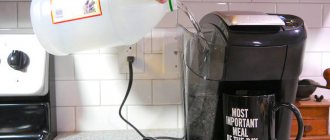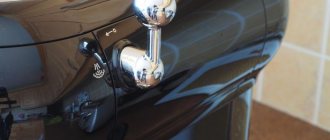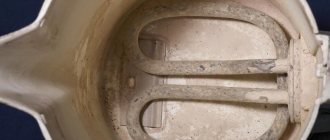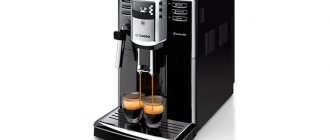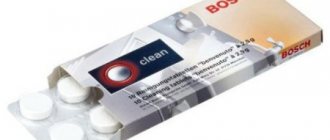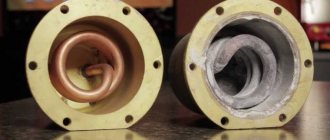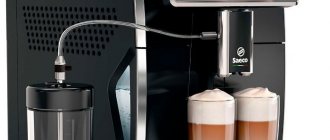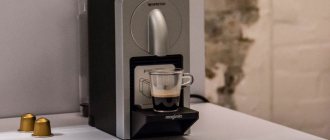Sediment is a common cause of coffee maker malfunctions. The appearance of a thick crust inside the device leads to its overheating and related failures. To eliminate possible problems, it is important to regularly treat the device with a special descaling agent for coffee machines.
Special products are used to descale coffee machines.
How scale forms
Drinking liquid contains various inorganic components that are responsible for its characteristic taste. Under the influence of high temperature, it is heated and breaks down into carbon dioxide and precipitated salts. Over time, these deposits settle on the heater and other components of the coffee machine, creating an additional insulating layer. This impairs the thermal conductivity of surfaces and forces the machine to operate at increased power.
When exposed to high temperatures, scale forms.
When to clean the device
If the coffee maker is used daily, it is recommended to remove sediment every month. Progressive models are equipped with an electronic control option, which automatically notifies about the degree of contamination of the equipment and the need for preventive cleaning. If such a system is not provided, you can take into account the number of portions brewed recently. The average is 200 cups of drink.
Cleaning Frequency
The frequency of decalcification of the coffee machine is determined by the degree of water hardness. The higher it is, the more often you will have to clean the device.
You can determine high salt concentrations using a kettle. If contaminants form frequently and quickly, it means the water is hard.
Methods for decalcifying a heating element
If you read the article before all these problems arise, they can be prevented. Just take the instructions for your device. It describes in detail all points of the process. The simpler the coffee machine, the more sequences, the more complex the technique, the shorter the process becomes. Instructions for decalcifying a coffee machine are your lifesaver. It would be unnecessary to describe the entire sequence here, since each device has its own. If the instructions are lost or you are tasked with cleaning office equipment, you have several options:
- Find a manual online. To do this, you need to enter the full name of the coffee machine, get the manual, find in it the item “Methods of care and cleaning” or something similar. Large manufacturers such as Delonghi or Jura can print everything you need on their websites.
- Invite your device into your home or send it to a service center, where experienced technicians will clean it for you. In this case, you need to remember - you will pay not only for the liquid or cleaning tablets, but for the work.
Rules for cleaning coffee machines with different coatings
The specifics of flushing depend on the material used to make the device. Some coffee machine surfaces require more careful care, while others are not afraid of the effects of abrasive compounds.
Ceramics
Cleaning ceramic surfaces is carried out in stages. To begin, pour 500 ml of liquid into the container of the coffee maker and add 2 tbsp. l. soda After boiling the components for 30 minutes, 20 g of citric acid is added to them. The cleaning mixture is brought to a boil again.
Cleaning ceramics is done in stages.
Plastic
You cannot clean plastic surfaces with vinegar. It is replaced with citric acid, adhering to the proportions - 1 packet per 1 liter of water. After the substance dissolves, the liquid is boiled. Cleaning the walls does not happen immediately, so it is better to repeat the procedure 2-3 more times.
Stainless steel
Stainless steel models can easily withstand the effects of vinegar, citric acid and other aggressive cleaning agents. The metal surface is not afraid of repeated washing and retains its clean appearance for a long time. Apple cider vinegar diluted with water in a ratio of 1:10 is suitable for processing.
Stainless steel tolerates citric acid well.
Electrical appliance
Vinegar should not be used when cleaning plastic-coated electrical devices. If the product is metal, you should prepare a cleaning solution based on 500 ml of liquid and 200 ml of 9% vinegar. The mixture is brought to a boil with the lid ajar.
Preventative cleaning of the coffee machine
Many articles and videos contain tips on cleaning coffee machines using citric acid, soda, and vinegar. Of all the above, you should use only citric acid, it is less aggressive. But even so, it must be diluted in water 1:10. The proportions should be observed carefully, since during operation you can damage the rubber pipes and other parts. It is better to buy an expensive Delonghi product than to later purchase spare parts for a new car. For preventative daily treatment, a weak solution of citric acid is suitable. Remember to rinse and wipe the brewing unit if possible. On many devices it can be pulled out. It won’t save you from scale, but it will prolong the period of the next global decalcification. Rinsing will remove any coffee oils.
Descaling your coffee machine is a necessary process. It will extend the life of your kitchen appliances and give you the pleasure of making delicious aromatic coffee.
Source
Anti-scale products
Cleaning products for the care of coffee makers are divided into several groups. The following types are particularly effective:
- Chemical cleaners.
- Softener filters.
- Decalcifiers.
Chemical
These products contain various acids. They are allowed for models coated in plastic, glass or steel. The substances are highly effective, but can negatively affect built-in automation and rubber seals.
Chemicals contain various acids.
Softening filters
They are distinguished by their ability to reduce water hardness, preventing the accumulation of plaque. After use, magnesium and calcium ions turn into sediment and do not interact with the heater.
Decalcifiers
There are 2 types of decalcifiers available for sale that can be used to clean the coffee maker:
- Pills. They are a mixture of chemical components that are compressed into a single substance for easy use.
- Liquid formulations. The cleaner dissolves instantly and does not contain any solid particles that may remain inside the machine.
Decalcifiers can be used to clean your coffee maker.
What is decalcification of a coffee machine?
The basic element of scale is calcium salts. They have a loose, porous structure and easily add other elements from the water: iron, magnesium, potassium, fluorine. Decalcification is the removal of mineral plaque by softening the calcium crust. It is impossible to scrape off plaque by mechanical means. Rough intervention is dangerous as it can damage the heating elements of the coffee machine.
Therefore, decalcification is carried out using special means that react chemically with calcium salts. As a result, the crust softens, crumbles and is easily removed with water. Modern industry produces ready-made products to combat plaque. Some coffee machine owners prefer traditional, low-cost life hacks that help deal with this problem.
Folk remedies
You can remove scale from your coffee machine using proven folk remedies. Their effectiveness has been proven by the experience of many users and experts.
Cleaning with citric acid
The method allows you to remove fresh scale from the coffee maker, which has not formed a thick layer and has not become hard. The food additive is safe for all plastic, metal and glass surfaces. To prepare the solution, you need to use 2 tbsp. l. acid diluted in 0.5 liters of water, which will allow you to obtain an effective and not overly aggressive composition.
Cleaning with citric acid removes fresh scale.
Cleaning with brine
The brine needs to be poured into the coffee machine reservoir and boiled for 25-30 minutes.
After this time, the contents will need to be shaken and waited until it cools completely. The method allows you to eliminate rust and sediment.
Cleaning with soda
The soda contains phosphoric acid, which effectively fights salt deposits on the surfaces of the device. It is recommended to use clear drinks when cleaning the coffee maker. Before using the liquid, the gas must be released to prevent the formation of foam. To do this, shake the bottle, and then carefully open it and wait until the bubbles are released.
Soda fights salt deposits.
After this, the soda can be poured into the device, boiled and waited for cooling.
INSTRUCTIONS FOR USE:
- pour one dose (100 ml) of ecological decalcifier into the water tank;
- add the amount of water specified in the instructions for use of the coffee machine. If the quantity is not indicated, add 1 liter of water;
- carefully follow the instructions for decalcification given in the operating manual of the coffee machine;
- After completing the decalcification cycle, rinse the tank with water and rinse according to the instructions in the machine manual. One dose (100 ml) is always sufficient for effective decalcification, regardless of the degree of dilution with water.
Features of cleaning individual elements of the coffee machine
When refinishing a coffee maker, it is important to clean several elements separately. Among them:
- Cappuccino maker.
- Brewing unit.
- Holder.
Holder
After the part is removed from the machine, a dark residue may be visible on it. To wash the device from dirt, use hot water, immerse the holder there for 20 minutes, and then wipe with a foam sponge (hard surface).
The holder is the part of the coffee machine into which the filter is inserted.
Cappuccino maker
Before processing the component, it is necessary to get rid of condensation. Then the part must be immersed in a container with hot water and soda for 20 minutes.
To completely remove scale, the surfaces should be rubbed with a sponge, rinsed and dried with a dry cloth.
Infuser
After 2 weeks, the brewing unit is removed from the machine and washed under clean water. Then it needs to be installed in its original place. If the part is not removable, then you need to place a cleaning tablet in the department for ground beans, place a large container under the horn and turn on the coffee brewing cycle.
The infuser is removed from the machine.
When to clean
Work on cleaning the device begins only after a problem is discovered - this is the main problem. We rarely read the instructions for devices in detail or throw them away without reading them. How to determine that the car has not yet broken down, but needs care?
- When preparing a drink, the liquid flows in a too thin, uneven stream.
- There is an additional hum, a strange noise from the coffee machine.
- A limescale deposit appears at the bottom of the cup with the finished drink.
- The machine begins to leak into the drip tray.
All these points are the first signal that something has happened to your equipment. One hundred percent of coffee machines have only two options if problems are detected: replacement of components, which often hits the budget, and decalcification in a service center. The second is something that every owner of the unit can do at home on a regular basis, avoiding costly repairs.
Many machines are equipped with a warning function about the need for preventive maintenance. Decalcification of a Delonghi coffee machine is carried out strictly after a certain number of cups. After the device has counted the required number of preparations, it will notify you about this and the corresponding icon will light up on the dashboard. Delonghi produces a wide variety of coffee machines, the equipment is expensive, so the company took care of its uninterrupted operation. The same thing happens with equipment from other manufacturers. Decalcification of the Jura coffee machine occurs after a certain amount of spillage through the heating element.
Anti-scale products
Criteria for choosing descalers for a coffee machine
To make the right choice of descaling agent for your coffee maker, you need to use the compositions recommended by the manufacturer. Some models are incompatible with common substances and require careful care.
There are no restrictions on the form of the cleaning substance. Tablets are easy to store, but take longer to dissolve. The gel acts quickly, but it lasts for 3-4 treatment cycles. The liquid consistency has a lower content of active substance, but is highly effective.
Rating of the best funds
To quickly descale your coffee machine, you need to use only proven tablets and cleaning products. The rating of the best drugs, according to reviews from experts and users, will help simplify your choice.
DeLonghi EcoDecalk
EcoDecalk is a new decalcification product that has an environmentally friendly composition and is suitable for all models. The liquid is based on raspberry and citric acids and is available in 500 ml bottles. This volume is enough for 5 processing cycles.
DeLonghi EcoDeca is a descaling product.
Philips Saeco Decalcifier
Philips Saeco Decalcifier is designed to care for Gaggia, Philips and Saeco coffee machines. It is sold in 250 ml bottles and is gentle on the internal surfaces of the device. The result of the treatment appears after a few minutes.
TOPPERR 3006
The concentrated composition ensures gentle but effective removal of plaque in different models of coffee machines. It is quite convenient to use this drug: you need to dilute it according to the instructions in the specified dosage, pour it into the reservoir and turn on the cleaning cycle. With the TOPPERR 3006 you can process carob and capsule machines.
TOPPERR 3006 is a concentrated composition.
Krups XS 3000
The drug was developed for the Krups XS 3000 model and is used to prevent scale. The tablets are able to cleanse the internal space of deposits and coffee oil.
Bosch Descaling
Bosch Descaling is sold in sealed packaging of 6 pieces. and is intended for quick cleaning of equipment from limescale. Properly selected proportions of ingredients do not have a negative impact on internal surfaces.
Bosch Descaling is designed for quick cleaning of equipment.
Top House
Produced in Germany and characterized by high decalcification efficiency. In addition, it prevents the appearance of rust. For 1 treatment cycle, 125 ml of product is required.
Durgol Swiss Espresso
The Swiss product is in demand among owners of automatic cars. It has a gentle but quick effect and is 5-10 times faster than descaling products from other brands in terms of response speed. Using a cleaning product, you can completely get rid of lime without additionally treating the coffee machine with chemicals.
Durgol Swiss Espresso is in demand.
Detergents for washing machines and dishwashers
An excellent cleaning composition from a Japanese manufacturer is intended for cleaning the internal parts of a washing machine. The product helps to cope not only with scale, but also kills spores, fungus and other microorganisms. Sold in tablets. At the rate of one tablet per use, included in the rinse mode.
- cleanses effectively;
- destroys mold, spores and bacteria;
- eliminates unpleasant odor;
- harmless to washing machine parts;
- ease of use;
- low price.
The product is produced in liquid form and is intended to remove and prevent the appearance of scale. Protects the internal parts of the washing machine from plaque. Used separately as a cleaner, and also in combination with washing powder. This allows you to save money and reduce water hardness.
- saves detergent;
- softens water hardness;
- removes scale and prevents its appearance;
- is used economically;
- does not harm the parts of the washing machine;
- does not leave odor or marks on things after washing.
- the result cannot be tracked;
- high price.
An excellent cleaner for washing machines and dishwashers. The main component in the composition is citric acid, which ensures effective descaling and does not harm parts. The product is sold in powder form, which is poured into the powder compartment and used in the rinse mode. If necessary, the procedure is repeated.
- contains natural ingredients;
- harmless to parts;
- thoroughly removes scale;
- good price.
Excellent powder from an Italian manufacturer. The main component of the composition is citric acid; additional components protect the internal parts of the washing machine from the effects of acid.
- excellent results the first time;
- there is no smell.
Comparison table of characteristics
| Name | Manufacturer country | Release form | Compatibility |
| DeLonghi EcoDecalk | Italy | Liquid preparation | All brands |
| Philips Saeco Decalcifier | Germany | Liquid preparation | Saeco, Philips and Gaggia |
| Krups XS 3000 | Germany | Tablet form | KRUPS Espresseria Automatic and Barista |
| Bosch Descaling | Germany | Tablet form | Bosch, Siemens, Gaggenau, Neff |
| Top House | Germany | Liquid | All brands |
| Durgol Swiss Espresso | Switzerland | Liquid composition | All brands |
| TOPPERR 3006 | Germany | Concentrate | All brands |
